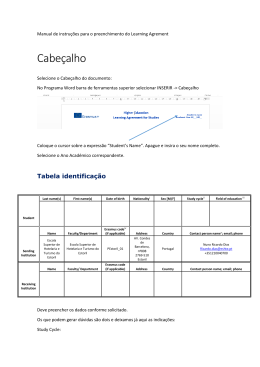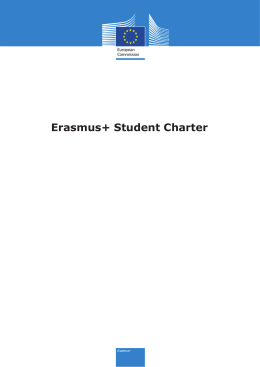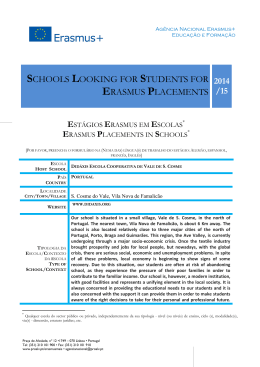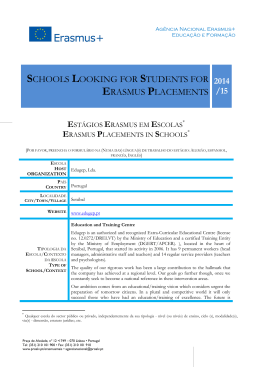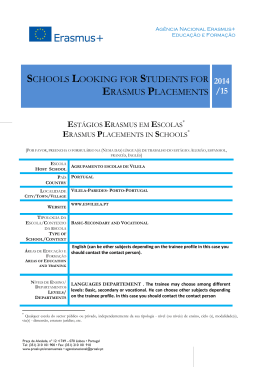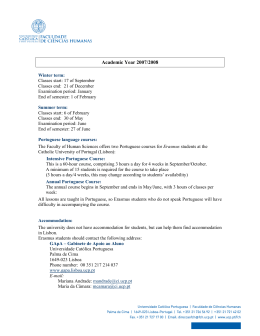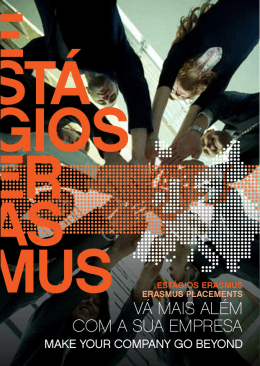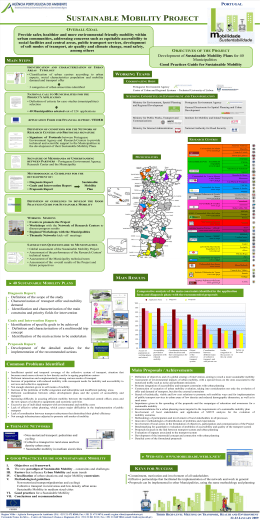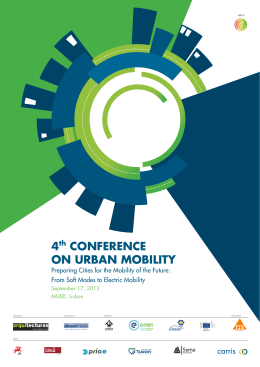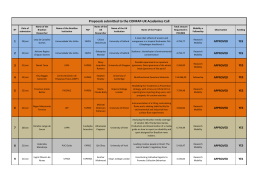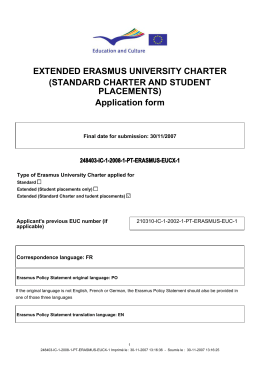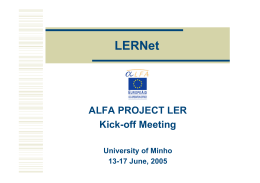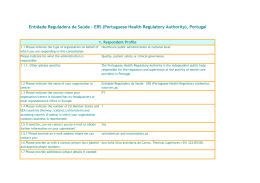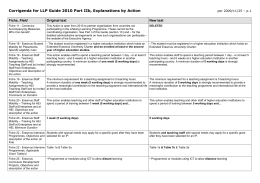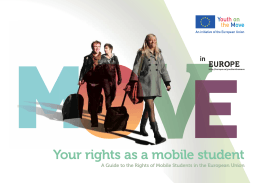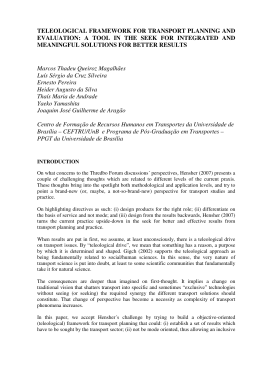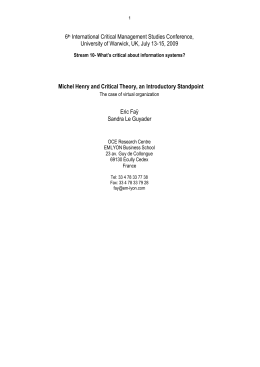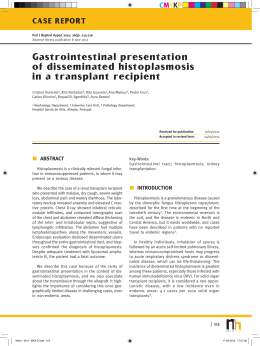Erasmus+ Mobility Projects Guide The new European programme for Education, Erasmus+, was launched on January 1st 2014. In-service training courses are now covered by Key Action 1 (KA1) of Erasmus+. EU funding for continuing professional development and other training in the education sector is available under the EU programme Erasmus+. This covers teachers and trainers from the European Union and from Iceland, Liechtenstein, Norway, Turkey and the Former Yugoslav Republic of Macedonia. Erasmus+ helps to cover course fees, travel costs, accommodation and other living costs and preparation costs for individuals and groups of teachers and trainers who wish to join an eligible training course. When you are planning an in-service training activity in a LLP project participants must apply for funding from the Erasmus+ action. You always have to apply to the National Agency. Significant changes There are a number of differences between the old and new programmes. the Comenius Catalogue or Database no longer exists and schools will have to research and identify their own contacts for training individuals can no longer apply, only institutions the application takes the form of a mobility project within the context of a European Development Plan. Conditions A mobility has to; be framed within a European Development Plan for the sending organisation respond to clearly identified staff development needs be accompanied by appropriate selection, preparation and follow-up measures ensure that the learning outcomes of participating staff are properly recognized ensure that the learning outcomes are disseminated and widely used within the organization European Development Plan If your school does not already have one, draw up a European Development Plan. This should identify your school’s development and training objectives for the next one or two years, taking a European dimension into consideration. Guide to Your European Development Plan: Annex 1 Eligible participants Staff in charge of school education (teaching and non-teaching, including school managers, heads, administration staff etc.), working in the sending school(s)as well as other educational staff (school inspectors, school counsellors, pedagogical advisors, phychologists, etc.) involved in the strategic development of the sending school(s). Observe that individuals can not apply. Only institutions can apply for staff members. You do not need to present the staff by name and occupation – only the numbers participants. Of course it is positive if you know names and CV on the participants. Duration of the project 1 or 2 Years. The applicant must choose the duration at application stage, based on the objective of the project and on the type of activities planned over time. You do not apply for a specific course, conference or activity but for a topic. You can choose the activity that in the best way qualifies your institutions objective as described in the application Duration of activity From two Days to two Months excluding travel time. You can include up to two travel Days in the Costs directly linked to the subsistence of participants during the activity (personnel costs). How many partners A mobility activity is transnational and involves minimum two participating organisations (at least one sending and at least one receiving organisation) from different countries. Receiving organisations do not need to be identified at the time of applying for a grant. Mobility Activities must be carried out abroad, in another programme country. You can not use the grant for any activity taking place in your own domestic country. Applying for funding The 2015 deadline is March 4th for training starting after 1st July 2015. As before schools need to apply through the national agency of their own country. Before being able to apply for funding a school needs to register on the European Commission Authentication Service (ECAS) and a Participants Identification Code (PIC), if not already registered. How to register on ECAS ECAS is the European Commission's user authentication service. It allows uthorised users to access a wide range of Commission information systems, using a single username and password. The personalised access is based on an account for each user (physical person). Therefore in order to access the different services mentioned above, users have to login first via their ECAS accounts. Creation of the ECAS account is possible from the Participant Portal. The unique identifier for a physical person in ECAS is his/her e-mail address. You can sign up here: ECAS (European Choose “External user”. Com m ission Authentication Service) How to obtain a PIC number The 9-digit Participant Identification Code is used to identify organisations throughout the different steps of a project's (mobility) lifecycle. 1. Please keep the basic legal data of your organisation at hand to facilitate the registration. 2. Access the Participants Portal: https://ec.europa.eu/education/participants/portal Access the "Organisations" tap and then “Register". 3. Fill in the requested information An automatic verification is done on each page of the registration wizard in order to detect potential duplicate registrations. If any pre-existing matching data is found, you may be able to use it without having to register again. You are able to save a draft registration at any time through the "Save draft" button. 4. At the end of the registration process, the PIC number of the organisation will be displayed Annex 2 I attach a successful Erasmus+ application as an example and inspiration Gert Larsen International Coordinator Albertslund Denmark European Development Plan Writing a European development plan For section D of the Erasmus+ application form, you have to answer three questions about your school’s European development plan. A European development plan is a strategic view of your school’s plans for European activities. It should include: an overview of your school’s current status (i.e. where you are now) a vision for the future (where you want to be in two, five or ten years’ time) identified needs (how you will get from where you are now to where you want to be) how your planned activities will meet these needs. Make sure your planned activities (i.e. your training courses) are relevant to both individual participants and your school as a whole. They will have a stronger impact on the quality of teaching and learning if well-integrated into your school’s strategic development. The European development plan should give a context for your application, and focus on internationalisation and modernisation, identifying staff development needs and making sure that information is disseminated and widely used. The best way to do this would be to look at the learning objectives on the description of the course you are applying for, and work these into your application. Question 1 The question asks: What are the organisation’s needs in terms of quality development and internationalisation? Please identify the main areas for improvement (for example management competences, staff competences, new teaching methods or tools, European dimension, language competences, curriculum, the organisation of teaching and learning.) Be as specific as possible in terms of areas identified in your answer here for further training, paying particular attention to internationalisation and the European aspect. A way to answer this could be: ‘Our school has little/no experience in … ‘(CLIL? New technologies in language teaching? Recent developments in teaching methodology?) ‘Our school there needs teachers who are able to…’ (use new teaching methods, network with colleagues in other parts of Europe…) ‘To do this, we need to…’ (develop a strategy for internationalisation, manage activities with our European partners, make sure all our projects have certain quality standards, give our students internationally-recognised certification, make sure knowledge and skills are disseminated throughout our school…) ‘A the specific course will help us to do this by…’ (equipping us with these skills, developing intercultural awareness, helping us to develop a network of international contacts…) Question 2 The question asks: Please outline the organisation’s plans for European mobility and cooperation activities, and explain how these activities will contribute to meeting the identified needs? Here, you should show how your plans for European mobility and cooperation activities fit into your plan as a whole and how the outcome of the training activities at the course/training activity will contribute to your organisational development over time. Include a note of how many people will be affected by the training – the more the better! (If there is more than one participant from your school, more ideas and skills will be gained and will be more widely disseminated.) You could begin your answer: ‘Our school wants to… ‘ Do not include more than two or three objectives. Make sure you aims are strategic, measurable, achievable and realistic. Say what your aims and policies are, how you are going to achieve them and how they will be evaluated. Continue by saying ‘Therefore training of staff is needed to acquire the following competences…’ (implementing a wide variety of international activities that can be carried out in cooperation with partner schools, evaluating international activities and the European dimension in the curriculum, disseminating the activities and outcomes, strengthening intercultural awareness…) Question 3 The question asks: Please explain how your organisation will integrate the competences and experiences acquired by staff participating in the project, into its strategic development in the future? Here, show how you will share the ideas and experiences from your course/training activities with specific reference to particular activities. For example, will teachers who take part in the course then give training sessions to their colleagues? Will you lead workshops or seminars on what you have learnt? Again, give a number of how many people will be affected by the outcomes of the training. Show how the mobility activity is part of a wider and long-term strategy of development and modernisation in your school and describe the impact the training will have on pupils, teachers, other staff and stakeholders and the school overall. You could begin your answer ‘Our school will…’, and continue by listing five or six things you plan to do.
Download
